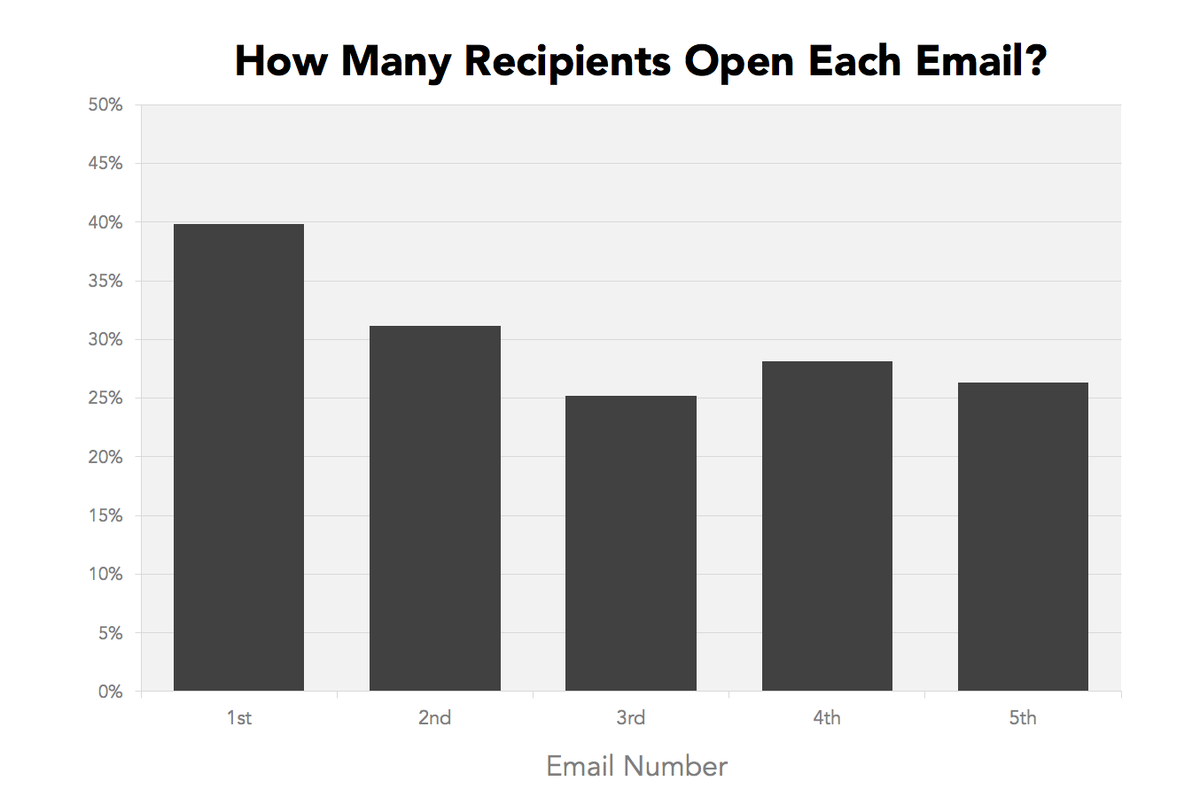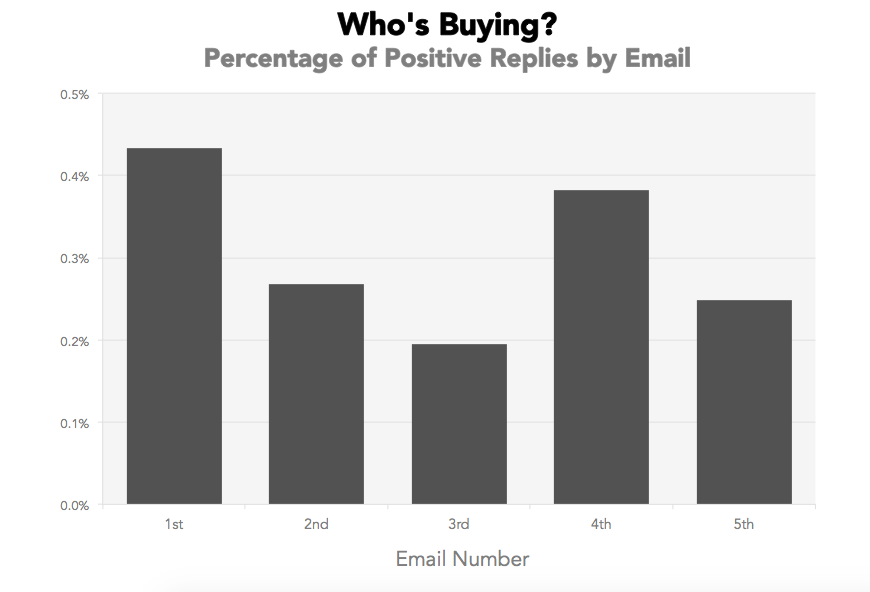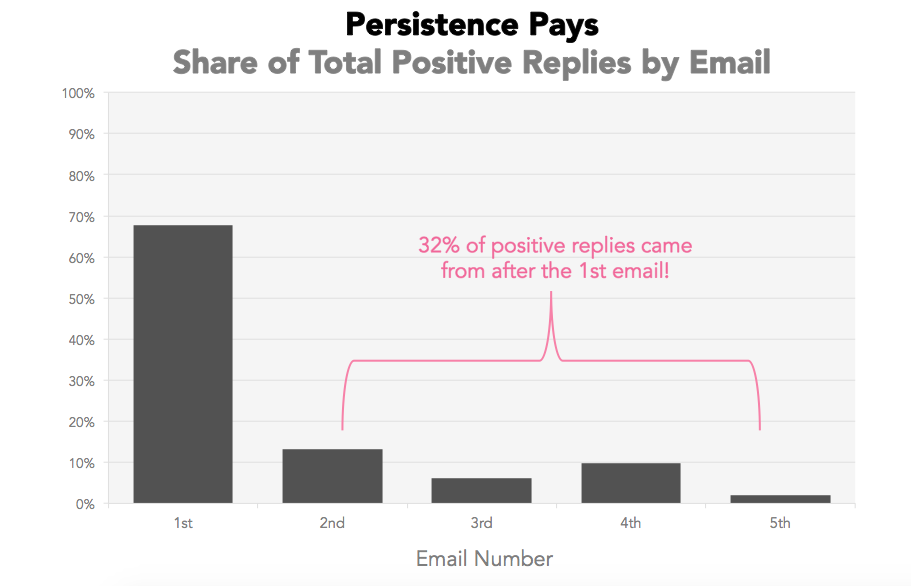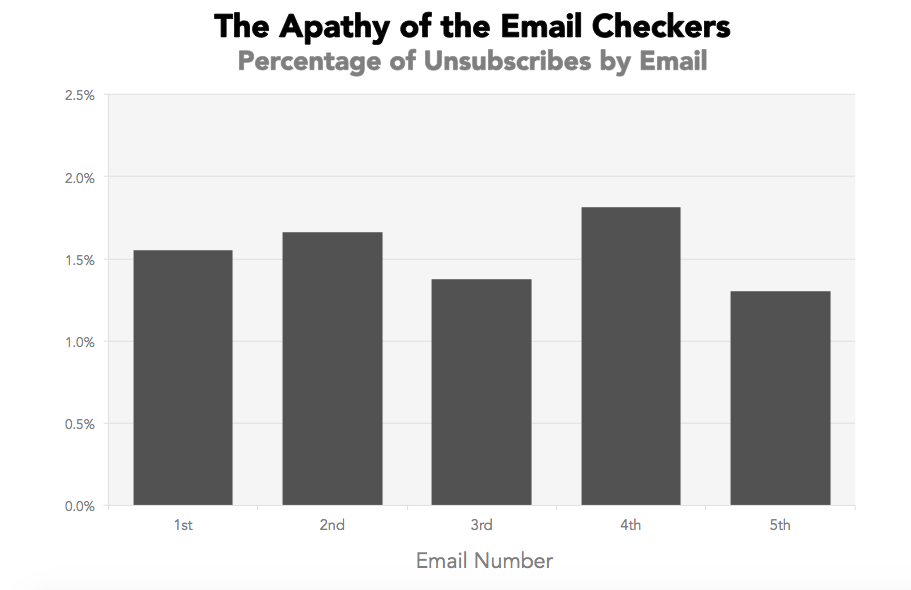Price Economics reports:
When salespeople send follow up emails to people who haven’t responded yet, they win a lot more business. In fact, the data suggests that salespeople give up too quickly and should send you more emails—32% of the positive replies in the data came from leads responding to the 2nd, 3rd, 4th, or 5th cold email. 40% open the first email, and 26% open the fifth email.If your job involves spending a lot of time battling your email, you’ve probably received an email from someone trying to sell you something. And then another one. And then another one. "Hey it's me again," they write in business casual. "Just following up to see if you got my last five emails!"Even if you don’t have a job where salespeople solicit your business, you’ve probably received multiple promotional emails from a favorite store or organization.And when you notice companies sending you the same or similar emails over and over, you probably wonder: Do they really think I’ll be interested the fifth time? Why do they bother to keep sending emails I don't respond to?Well, we’re prepared to answer that question. We analyzed data from LeadGenius, a Priceonomics client that helps companies find and communicate with customers. Part of this process involves helping them send emails and then measuring if people actually read and respond positively to them.The short answer to this question is simple: it works. When salespeople send follow up emails to people who haven’t responded yet, they win a lot more business.In fact, the data suggests that salespeople give up too quickly and should send you more emails—32% of the positive replies in the data came from leads responding to the 2nd, 3rd, 4th, or 5th cold email.***If you’ve ever emailed a friend, mentor, or co-worker without hearing a response, you’ve probably debated whether to send another email. Will you seem annoying or desperate?Salespeople face the same dilemma—at scale. It seems like common sense to assume that the open rate will fall precipitously after the first email. After all, why would anyone open a sales email if they ignored the first one?But that’s not what happens in practice.Data source: LeadGeniusWhen LeadGenius customers send follow up sales emails—after not having received a response—fewer people open the emails. But the decline is modest: 40% open the first email, and 26% open the fifth email.We can also look at how many leads replied with interest to an email. When we do, we once again find that the first email leads to the most potential business—but not by much:Data source: LeadGeniusIt seems reasonable after sending 3 emails to assume you won’t get a response. But LeadGenius customers who sent a 4th email received almost as many positive replies as they did from their first email.The result of this surprising dynamic is that companies working with LeadGenius received a whopping 32% of their positive replies from the 2nd, 3rd, 4th, and 5th emails they sent—even though not everyone kept sending 4th and 5th emails.Data source: LeadGeniusSending a sales email followed by a single follow up email might strike you as a good, polite policy. Yet almost 20% of the successful replies came in response to emails number 3, 4, and 5. If anything, salespeople might be making a mistake by not sending more follow up emails.There are still good reasons to exercise restraint—sending too many emails could deter business.One way that this could happen is by ruining the positive brand impression companies want to cultivate. Nagging in the present could ruin future business opportunities. Another fear is that sending too many emails could lead to unsubscribes and SPAM complaints. Under American law, anyone sending an email for business purposes has to offer a way for people to opt-out of future emails, which is usually accomplished by including an Unsubscribe button. By emailing people until they unsubscribe, salespeople could lose their entire company access to people whose business they covet.Yet the data does not show this happening. When customers in this data set email leads, the leads unsubscribe at a lower rate in response to a 5th email than they do to a first email.Data source: LeadGeniusEven when salespeople send 5 emails without getting a reply, there’s no sign that people revolt at receiving all these emails.***So what’s going on?We suspect that follow up emails do nearly as well as a first email because all emails risk getting lost in a sea of communication. The Radicati Group research firm estimates that the average worker receives 121 business-related emails each day, and managers who are the targets of sales emails usually receive even more.Consider the experience that journalist Minda Zetlin relates in an article about pitching a former client. She emailed four times and called twice without receiving a response.This seems like a clear sign of a lack of interest. But Zetlin called one more time, and the client picked up and agreed to the pitch. “She hadn't read or didn't remember my emails or phone messages,” Zetline writes.Everyone has different email habits and different ideas about email etiquette. But one constant is that it’s rarely a good idea to assume that someone has seen an email just because you sent it once.So why do you keep receiving the same sales emails over and over? Because it works, and because the only way to reach people lost in a torrent of email is to just keep trying.
























0 comments:
Post a Comment